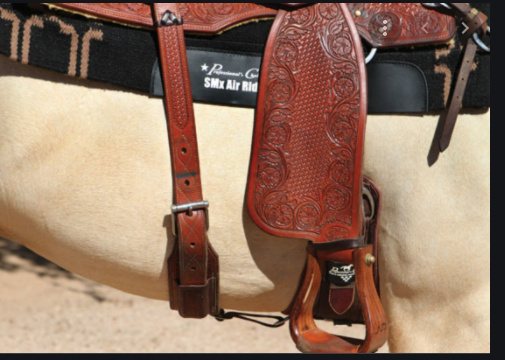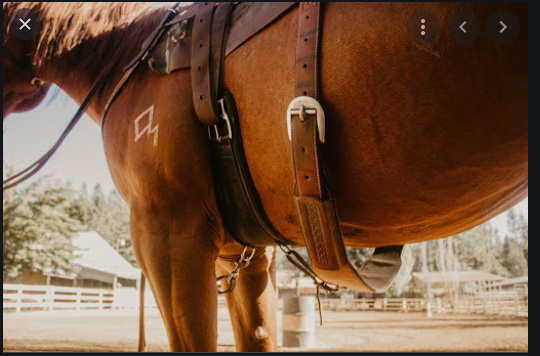Uh, no.
Ok
Interestingly enough, the USEF/WDAA rules for tack specifically prohibit “Australian, Baroque, English, McClellan, and Spanish” saddles. You must use an American Western stock saddle or working Western side saddle.
You know what? I bet that’s a rule at least in part due to the lack of fenders on the stirrups on those saddles. Fenders are required. And I was thinking earlier, “Damn, I would not want to attempt tempi changes in a Western saddle because of the stirrups!” The fenders change the stability of the stirrups. And probably the rider’s lower leg, too.
The rules have parameters which make a level playing field for all contestants. Therules are explicit, and everyone had to follow them. The equipment is part of the training and performance of the horse. Using different equipment would make your competitors unequal. Its why all sports have rules.
They do all look lame and unhealthy. I don’t pretend to know why Western Pleasure is a “thing”.
Her back cinch is loose. It’s evident in the photo that it’s not the least bit snug.
That makes sense, thanks for explaining.
Pro-tip to dodge the Starbucks Price Gouge: you can get a latte at Starbucks for $2.95 – order a “quad ristretto over ice” and then ask for a milk topper. I go every Friday before work and the same latte made regularly is over $6 
On the subject of horses and liking western saddles better – there are a lot of reasons a horse might prefer one type of saddle over the other, not all of them having to do with physical complaints. It all boils down to anatomy and preference. There is really nothing outrageous about someone saying that - it’s just like one person liking sneakers better than moccasins and another finding moccasins unbearable.
Western saddles typically distribute weight over a broader surface with less surface pressure - and there are a lot of reasons a horse might prefer this.
I have one horse who finds western saddles absolutely intolerable - he doesn’t seem to like any weight or pressure past the center of his back.
I have another gelding with diagnosed & managed kissing spine on T8/T9 - which is right where the central weight of an english saddle rests. I could not for the life of me find a dressage saddle that he enjoyed. I found many that fit him on paper and the fitter flocked many to his back, but after a few weeks of test riding in them he would show that he was unhappy. Frankly, I got tired of dumping all of this $$ for dressage saddles (at this point I spent so much on various fittings that I could have purchased two custom dressage saddles) and started exclusively riding him in his XC saddle, which he never had issue with. We tried the dressage version of my XC saddle with no positive results. Something about a dressage saddle bothers him - the saddle fitter thinks it may be related to where the stirrup bar is placed on dressage saddles. This same horse has no problem with a western trail saddle.
At some point you have to stop throwing money at something you can’t get to the bottom of, and just listen to the horse.
Yes. They’re not meant to be snug.
Just because they are meant to be loose doesn’t mean they can’t be misused. It’s my point - if western tack was to be allowed in english disciplines many specifications will have to be addressed: how loose must the back cinch be (ala the two fingers under the noseband rule), must you use a english bridle and if a western bridle is ok - what about the fact that most of them do not have nosebands? I could come up with a much longer list - these are but two examples.
Lol, no, they are not. As you correctly stated in your earlier post about the OP’s Wade, that saddle has a functional rear cinch so that you can snug it up and go a little easier on the front cinch. Do you HAVE to? No, not unless you’re roping. But if you are going to suggest the OP is enjoying the benefits of a snug rear girth, she is going to have to take it up a few holes.
PS I gave two custom hardseat western saddles in my tack room, right next to my dressage saddles 
Oh, I agree. And support the current saddle rules in place for both the WDAA & USDF. I just wasn’t sure what Djones meant by their response to my original comment.
Ironically, I learned how to tie a western cinch from an Austrian horsewoman. She had come to the US on a Baptist mission trip to Texas & fell in love with & married a fellow missionary who was American. She had two Wintec saddles; one dressage & one western that she used while teaching the occasional beginner lesson on one of her lovely aged schoolmasters. And if that doesn’t sum up the USA in a nutshell, I don’t know what does!
I have been thinking about the OP’s original question, which I interpreted to be theoretical discussion point, rather than a complaint or an attempt to change the rules.
Why do the rules specifically state that it must be english tack? Is it tradition or is it something that is integral to the sport? Some traditions are in the rulebook and some are not, but I think any aspect that is traditional can be changed without changing the sport, but any aspect that is integral cannot be changed without changing the sport as a whole.
My opinion is that english tack is integral to the sport, the same way that you must ride a horse and not a camel, or that you must wear breeches and not bike shorts. Some items that are traditional are the color of the saddle or the breeches.
Thoughts?
But if you are going to suggest the OP is enjoying the benefits of a snug rear girth…
No, that wasn’t my suggestion. 
I was speculating that one reason the horse may prefer the OP’s western saddle is because the use of the back cinch might allow for looser girthing on the front cinch than could reasonably be achieved on a single girth English saddle. Iirc the only benefit to a tight back cinch would be the chance to practice your bronco riding skills. 
Hope that clears it up. It was late & I was tired & effective word smithing sometimes eludes me. Lol.
Lol it’s all good.
The “back cinch” is called the flank cinch. It is only tightened for use as a bucking strap. Otherwise it should be quite loose. It’s purpose is similar to the throatlatch on your snaffle bridle. An outdated “failsafe” should the rider be out in the bush and have the cinch break or fail.
The “back cinch” is called the flank cinch. It is only tightened for use as a bucking strap. Otherwise it should be quite loose. It’s purpose is similar to the throatlatch on your snaffle bridle. An outdated “failsafe” should the rider be out in the bush and have the cinch break or fail.
That makes no sense to me! If your main cinch gave out on the trail, I can quite see the flank cinch turning into a bucking strap.
I have always been taught to keep it snugged up, never loose, because it’s function is to stabilize the back of the saddle while working, especially roping.
Two main problems with being loose, getting something caught in it, or a foot caught if a horse is kicking flies, and the fact that if it’s loose and the back of your saddle comes up for some reason, it will smack the horse, rather than just acting as a cinch.
I have always been taught to keep it snugged up, never loose, because it’s function is to stabilize the back of the saddle while working, especially roping.
This is what I was taught too.
I am not saying it should be ‘hold the saddle in place’ tight. Just not hanging loose.
Disclaimer - I do not typically ride western, so I might not be correct, I might have been taught incorrectly.
Random internet photo I snagged a screen shot of.

Not like this: (another random internet photo I took a screen shot of)

Maybe this will be considered a bad reason by some, but as someone who has volunteered a lot for shows of many types, every new “weird” (by the traditional standards of the sport) piece of tack that gets approved makes it that much harder for a volunteer to correctly execute a tack check. The more complex the check is, the fewer people will be able to comfortably execute it.
Maybe western saddle type A gets approved, but saddle B does not. Now a dressage person who volunteers to steward but doesn’t know squat about western saddles flips through an appendix to check the type of your saddle and finds it ambiguous, has to call in help from a td, who says it is not approved - then what do you do? No thank you. It is not worth the logistical overhead, especially when wd already exists.
I was thinking about this recently with new bridles and bits. Manufacturers maybe should be listing which rulebooks currently approve their tack. I would love that as a consumer who dabbles in multiple disciplines, but does not show often. The rules probably change more frequently than I review them.
@trubandloki You are absolutely correct, the main function of the back cinch is to keep the back of the saddle from flipping up while roping cattle (or whatever). All cow horses should be broke to it being snug (not tight as in girth tight, but not loose either) so that it does NOT become a bucking strap, but merely another piece of leather. I do not rope, never have, but always use a rear cinch and have it snug. It’s like anything else you train your horse to accept willingly. If left loose like the second picture, it becomes more of a hazard than a help and might as well be removed altogether.
